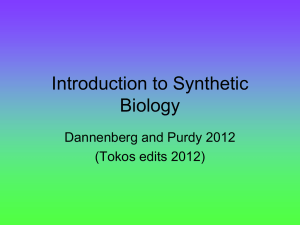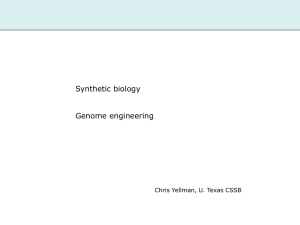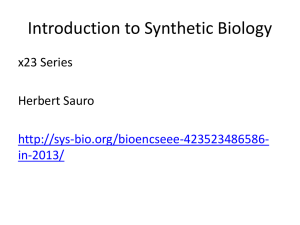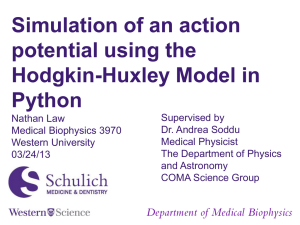reu2012_june20_seminar
advertisement
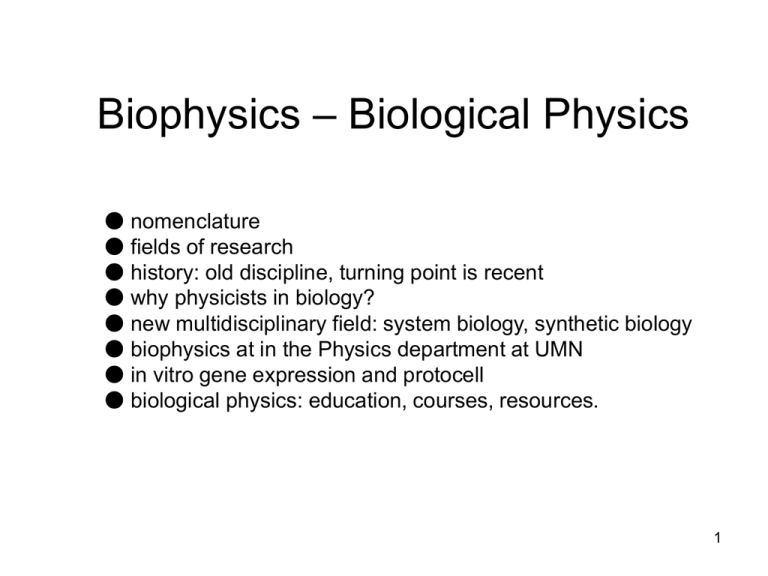
Biophysics – Biological Physics ● nomenclature ● fields of research ● history: old discipline, turning point is recent ● why physicists in biology? ● new multidisciplinary field: system biology, synthetic biology ● biophysics at in the Physics department at UMN ● in vitro gene expression and protocell ● biological physics: education, courses, resources. 1 Biophysics / Biological Physics Biophysics: - more used among physiologists, biochemists - molecular level Biological physics: - preferred by physicists - molecular to ecological Ideas of biophysics or biological physics are the same: - fundamental physics of biological systems and processes. - apply the techniques from physics to understand biological structure and function. 2 Biophysics, major components / examples - explain biological function in terms of molecular mechanisms - ions channels - protein 3D structures and functions (crystallography) - DNA replication - conversion of external signals to electrical signal - conversion of chemical energy to mechanical force (muscle) ATP hydrolysis = 20 kBT 1 kBT =1 pN nm 3 Biological physics, major components / examples - molecular: channels in membranes, dynamics of chemical reactions - subcellular: transport, signal processing, dynamics of polymerization, motility, flagellar dynamics - cellular: chemotaxis, swimming, crawling, growth - multicellular: pattern formation, morphogenesis - organism: cardiac dynamics, circadian rhythms, information processing - evolution / ecology: in vitro evolution, population dynamics 4 History Ideas are not new: ● D’Arcy Thompson (1860-1948) talking about cells, tissues, bones, flowers: “Their problems of form are in the first instance mathematical problems, their problems of growth are essentially physical problems.” ● E. Schroedinger: “what is life?” (1944). Recent field in terms of research effort: - became clear in the past decade: explosion of meetings, journals. - many departments building research groups in biophysics / biological physics. 5 Why physicists in biology? What physicists can bring: - quantitative measurements - modeling and testing - reductive approaches - universality of behavior - development of new methods and technologies - in vitro / synthetic approaches 6 Biophysics Group Theory: Alexander Kamenev Boris Shklovskii Experiment: John Broadhurst David Thomas Joachim Mueller Vincent Noireaux 7 Prey Population Alex Kamenev 1. Populations dynamics, as an example of non-equilibrium statistical mechanics. Predator Population 2. Transport through ion channels, as an example of 1D physics. 8 Electrostatic theory of viral self-assembly Boris Shklovskii r R 9 Thomas Lab Spectroscopic Probes of Muscle Protein Structure and Dynamics Myosin Cardiac Calcium Pump ATP ADP + Pi Ca2+ ATP ADP + Pi Phospholamban Ca2+ Actin Probes Spectroscopic Probe Methods: Electron paramagnetic resonance (EPR) Nuclear Magnetic Resonance (NMR) Time-resolved fluorescence and phosphorescence O O H N C CH2I •N I HO I O O I I COOH 10 N=C=S J. Broadhurst Magneto encephalography (MEG) Study the location in the human brain of the processors of external stimuli. Currently work is being done on the identification of different sounds by a part of the brain above and in front of the ear. (This part is known as the auditory cortex, and is located in a fold of the brain called the sylvan fissure). When a sound is received by the ear, it is analyzed into the different frequencies that it contains, before being passed on to the first level of processing. This identifies loudness and the direction of the sound source, and then transmits the information to the second processor, which tries to identify the identity of the sound (Is it a violin, or a cat meowing?) Neurons in the brain activate and produce tiny magnetic fields (10-12 Tesla ). An array of 250 superconducting magnetometers (squids) are used to measure the fields. 11 Mueller Lab: Fluorescence Fluctuation Spectroscopy (FFS) Two-Photon Spot objective Single-molecule microscope FFS in cells Two-photon Effect Watch Protein Interactions in Living Cells: Concentration (nM) 2 10000 4 10 10 dimer 9000 8000 app(cpsm) Photon Count Statistics 3 10 7000 RAR LBD TR4 6000 5000 4000 3000 12 monomer 2000 4 10 10 5 Intensity (Counts per second) 10 6 Joachim Mueller: Viruses Protein Assemblies and Fluctuation Analysis 2-photon spectroscopy Light burst from single molecules passing through tiny optical volume Image of a cell assembling viral-like particles. We study assembly process of retroviruses, such as HIV-1. Construct physical model of assembly pathway Harvest viral particles Fluctuation Analysis 5500 Intensity (cps) 5000 4500 Viral Particle 4000 3500 3000 2500 2000 0 100 200 time (sec) Microfluidics of viral particles 300 400 • protein coat contains holes • the hole density varies • below percolation threshold 13 Vincent Noireaux ● information processes (synthetic genetic circuits). ● biopolymer self-assembly at the membrane: cell division, motility, nano by bio. ● artificial cell system. Reconstitution of genetic circuits in vitro. Coarse-grained model of circuits. Artificial cell system. Self-assembly of proteins/biopolymers. 20μm 14 Vincent Noireaux ● information processes (synthetic genetic circuits). ● biopolymer self-assembly at the membrane: cell division, motility, nano by bio. ● artificial cell system. genome DNA of virus cell-free expression in test tube de novo synthesis of virus 15 Biophysics courses at UMN ● Physics department: - 4911/5081: intro. to biopolymer physics. - 5401: physiological physics. - 5402: radiological physics. ● other courses: - Math 5445: mathematical analysis of biological networks. - Math 8540: topics in mathematical biology. - biology courses. 16 DNA sequencing and synthesis Sequencing of bacterium genome: 1 week (5 Mb) 17 Information man-made nature - evolution 18 New interdisciplinary fields ● system biology: (1) understanding the structure of the system, such as gene regulatory networks. (2) understanding the dynamics of the system, both quantitative and qualitative analysis. (3) understanding the control methods of the system. (4) understanding the design methods of the system, are key milestones to judge how much we understand the system. ● synthetic biology: the design and fabrication of biological components and systems that do not exist in the natural world. Use them either as molecularscale factories, to make simple computations, deliver vaccines, or to create new hybrid materials. Like system biology, synthetic biology is at a very preliminary stage but physicist could have a significant scientific impact. 19 Molecular programming in a test tube: synthetic gene circuits, phage synthesis and artificial cell. Vincent Noireaux, UMN 20 1 Introduction – Motivations • The three components of cellular life. • the bottom-up approach to living systems. 21 Living cell (bacteria E. coli) DNA RNA proteins Genome (DNA): - 5 millions bases - 4500 genes - hundreds gene circuits Genome (DNA) Nutrients 1 μm (E. coli) Self-reproduce in 30 min. Capable of: - responding to stresses - sensing the environment 22 Cell: the basic unit of life Information Compartment Metabolism Unique property: self-reproduction. Each part is essential. Each part is made of molecular machineries. 23 Synthetic biology era The design and fabrication of biological components and systems that do not exist in the natural world: • to understand gene regulation and make simple computations. • to use them either as molecular-scale factories. • to create new hybrid materials. 24 Synthetic biology platforms in vivo in silico in vitro 25 Synthetic biology in a test tube (cell-free synthetic biology) Constructing living systems in a test tube from the DNA program. DNA TX mRNA TL protein ● bottom-up, reductionist and constructive approach. ● no endogenous information. ● no interference and response from an organism. ● more freedom of control and design compared to in vivo. ● molecular programming approach to living systems. 26 2 Small gene circuits in a test tube (DNA TX mRNA TL protein)n circuits 27 Transcriptional activation cascade σ70 P70 σ28 P28 deGFP 28 AND gate S54-NtrC 29 Multiple stage cascade σ70 P70 σ38 P38 σ19 P19 σ28 P28 T7rnap PT7 deGFP m 12 2 min Leak! Loss of specificity 30 Multiple stage cascade σ70 P70 σ38 P38 σ19 P19 σ28 P28 T7rnap PT7 deGFP m 6 1min Leak attenuation Specificity 31 Conclusion: • constructed and characterized cell-free circuits. • learned the design rules. • tuned the dynamics. • global mRNA degradation rate is critical. • Shin and Noireaux. ACS Synthetic Biology 2011. Information Compartment Metabolism 32 Genome scale circuits (information and self-organization) ● What is the real capacity of the system to construct circuits and living systems? 50-60 genes CFR batch mode: [Protein] = 25-30µM E. coli: [Protein]ave = 500nM ● Test the system with genome-sized information. ● Bacteriophages: - search for genomes composed of ≤ 60 genes. - with molecular biology technically accessible. - condition/bottleneck: complexity of the interaction with the host beyond TX-TL. 33 Phage T7 ● ● ● ● ● lytic coliphage. 40 kbp, 60 genes (35 with known functions). almost host independent (2 host proteins required). has its own RNA polymerase. has its own DNA polymerase. 34 Phage T7 synthesis in a test tube TX genome TL mRNA phage ● TEM image ● 5-6 hours of incubation ● batch mode reaction 35 T7 Genome replication ● up to 200 times greater with dNTPs. ● a few billion of functional phages per milliliter synthesized after 5-6 hours of incubation in batch mode. 36 T7 - E. coli Infection test No difference observed between in vivo and in vitro synthesized phages. ● phages per cell ≈ 100. ● phage cycle ≈ 25 min. ● E. coli division ≈ 30 min. 37
